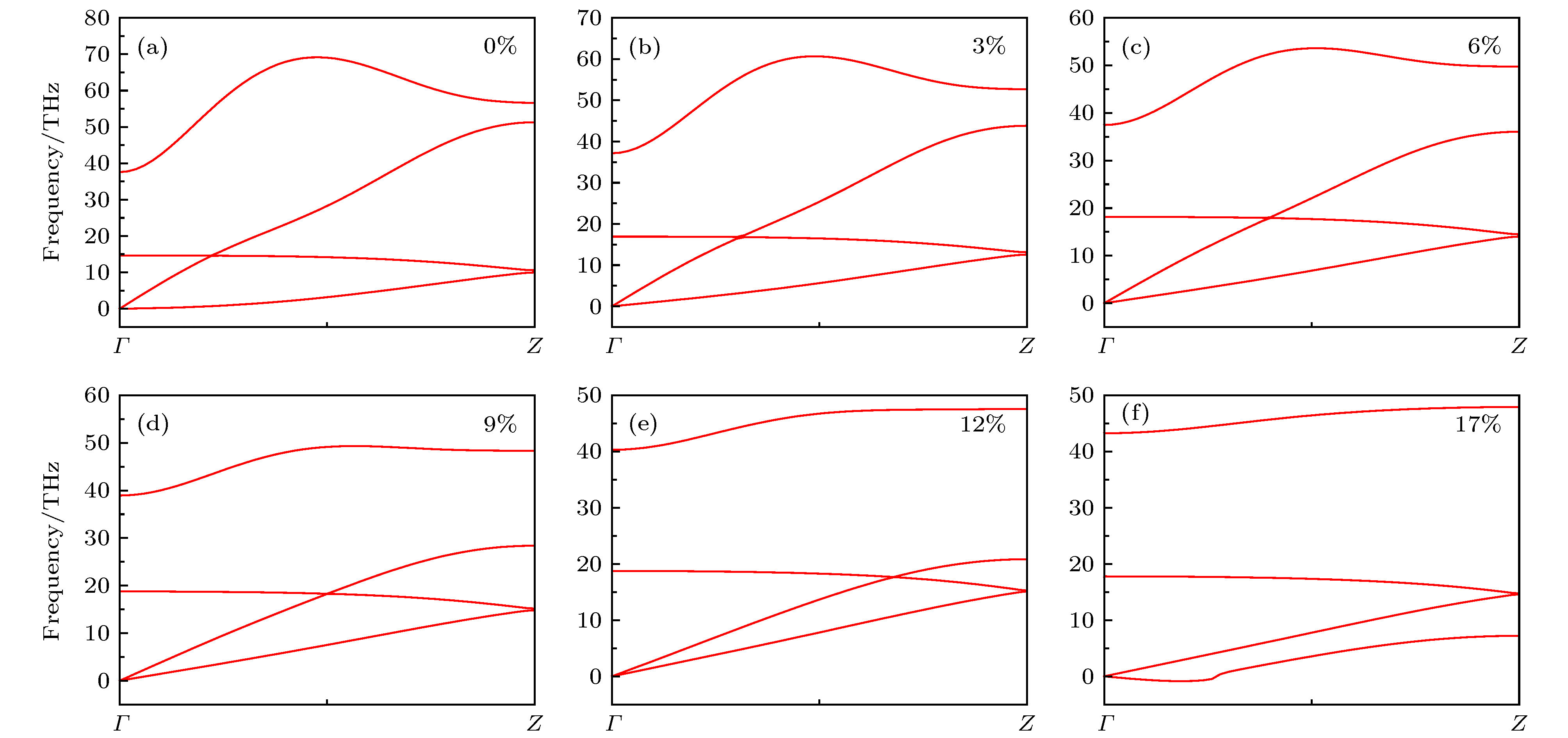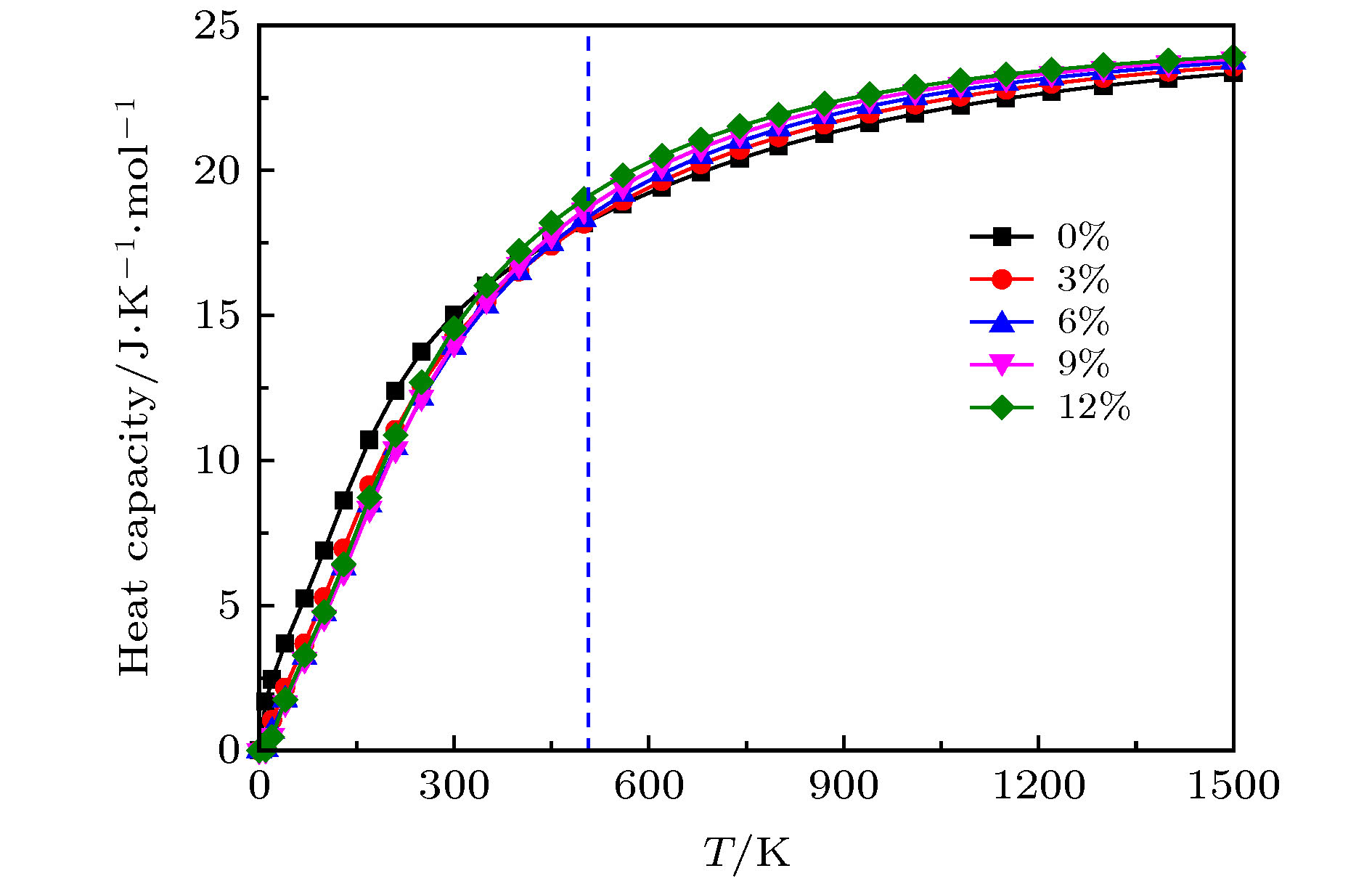-
One-dimensional (1D) carbyne chain has the potential applications in the nanoelectronic devices due to its unique properties. Although some progress of the mechanical and thermal properties of 1D carbyne chain has been made, the physical mechanism of the strain modulation of atomic bond nature remains unclear. In order to explore the strain effects on the mechanical and related physical properties of 1D carbyne chain, we systematically investigate the strain-dependent bond nature of 1D carbyne chain based on the first-principles calculations of density functional theory and generalized gradient approximation. It is found that when the compressive strain is 16%, the bonding nature of 1D carbyne chain is changed, and the bond length alternation of single and triple bonds in 1D carbyne chain tends to zero, which originates from the difference in bond strength between single bond and triple bond. Moreover, 1D carbyne chain can change from semiconductor into metal when the compressive strain is 16% indicated by analyzing the band structure and related differential charge density. When the strain is 17%, the phonon spectrum has an imaginary frequency. Besides, when the ambient temperature is less than 510 K, the heat capacity of 1D carbyne chain decreases with strain increasing. However, more phonon modes will be activated at larger strains when the temperature is higher than 510 K, and the heat capacity is enhanced gradually with strain increasing. Also, the stiffness coefficient of 1D carbyne chain is larger than that of graphene and carbon nanotube. These results conduce to the fundamental understanding of atomic bond nature in 1D carbyne chain under different strains.
-
Keywords:
- carbyne /
- first-principles calculations /
- electronic structure /
- heat capacity
[1] Novoselov K S, Geim A K, Morozov S V, Jiang D, Zhang Y, Dubonos S V, Grigorieva I V, Firsov A A 2004 Science 306 666
 Google Scholar
Google Scholar
[2] Bolotin K I, Sikes K J, Jiang Z, Klima M, Fudenberg G, Hone J, Kim P, Stormer H L 2008 Solid State Commun. 146 351
 Google Scholar
Google Scholar
[3] Cao A Y, Dickrell P L, Sawyer W G, Ghasemi-Nejhad M N, Ajayan P M 2005 Science 310 1307
 Google Scholar
Google Scholar
[4] Boyd A, Dube I, Fedorov G, Paranjape M, Barbara P 2014 Carbon 69 417
 Google Scholar
Google Scholar
[5] Dillon A C, Jones K M, Bekkendahl T A, Kiang C H, Bethune D S, Heben M J 1997 Nature 386 377
 Google Scholar
Google Scholar
[6] Chen P, Wu X, Lin J, Tan K L 1999 Science 285 91
 Google Scholar
Google Scholar
[7] Baughman R H, Zakhidov A A, De Heer W A 2002 Science 297 787
 Google Scholar
Google Scholar
[8] Liu M J, Artyukhov V I, Lee H, Xu F, Yakobson B I 2013 ACS Nano 7 10075
 Google Scholar
Google Scholar
[9] Zhang Y Z, Su Y J, Wang L, Kong E S W, Chen X S, Zhang Y F 2011 Nanoscale Res. Lett. 6 577
 Google Scholar
Google Scholar
[10] Pan B, Xiao J, Li J, Liu P, Wang C, Yang G 2015 Sci. Adv. 1 e1500857
 Google Scholar
Google Scholar
[11] Kotrechko S, Timoshevskii A, Kolyvoshko E, Matviychuk Y, Stetsenko N 2017 Nanoscale Res. Lett. 12 327
 Google Scholar
Google Scholar
[12] Akdim B, Pachter R 2011 ACS Nano 5 1769
 Google Scholar
Google Scholar
[13] 周艳红, 许英, 郑小宏 2007 物理学报 56 1093
 Google Scholar
Google Scholar
Zhou Y H, Xu Y, Zheng X H 2007 Acta Phys. Sin. 56 1093
 Google Scholar
Google Scholar
[14] Sorokin P B, Lee H, Antipina L Y, Singh A K, Yakobson B I 2011 Nano Lett. 11 2660
 Google Scholar
Google Scholar
[15] Cannella C B, Goldman N 2015 J. Phys. Chem. C 119 21605
 Google Scholar
Google Scholar
[16] Andrade N F, Aguiar A L, Kim Y A, Endo M, Freire P T C, Brunetto G, Galvao D S, Dresselhaus M S, Souza Filho A G 2015 J. Phys. Chem. C 119 10669
 Google Scholar
Google Scholar
[17] Wang M, Lin S 2015 Sci. Rep. 5 18122
 Google Scholar
Google Scholar
[18] Liu F, Ming P, Li J 2007 Phys. Rev. B 76 064120
 Google Scholar
Google Scholar
[19] Lu J P 1997 Phys. Rev. Lett. 79 1297
 Google Scholar
Google Scholar
[20] Nair A K, Cranford S W, Buehler M J 2011 Eurphys. Lett. 95 16002
 Google Scholar
Google Scholar
[21] Artyukhov V I, Liu M, Yakobson B I 2014 Nano Lett. 14 4224
 Google Scholar
Google Scholar
[22] Yang X G, Lv C F, Yao Z, Yao M G, Qin J X, Li X, Shi L, Du M R, Liu B B, Shan C X 2020 Carbon 159 266
 Google Scholar
Google Scholar
[23] Zhang Z, Zhao Y P, Ouyang G 2017 J. Phys. Chem. C 121 19296
 Google Scholar
Google Scholar
[24] Dong J S, Ouyang G 2019 ACS Omega 4 8641
 Google Scholar
Google Scholar
[25] Kresse G, Furthmüller J 1996 Phys. Rev. B 54 11169
 Google Scholar
Google Scholar
[26] Kresse G, Furthmüller J 1996 Comput. Mater. Sci. 6 15
 Google Scholar
Google Scholar
[27] Perdew J P, Burke K, Ernzerhof M 1996 Phys. Rev. Lett. 77 3865
 Google Scholar
Google Scholar
[28] Blöchl P E 1994 Phys. Rev. B 50 17953
 Google Scholar
Google Scholar
[29] Monkhorst H J, Pack J D 1976 Phys. Rev. B 13 5188
 Google Scholar
Google Scholar
[30] Togo A, Tanaka I 2015 Scr. Mater. 108 1
 Google Scholar
Google Scholar
[31] Ma F, Zheng H B, Sun Y J, Yang D, Xu K W, Chu P K 2012 Appl. Phys. Lett. 101 111904
 Google Scholar
Google Scholar
[32] La Torre A, Botello-Mendez A, Baaziz W, Charlier J C, Banhart F 2015 Nat. Commun. 6 6636
 Google Scholar
Google Scholar
[33] Li J P, Meng S H, Lu H T, Tohyama T 2018 Chin. Phys. B 27 117101
 Google Scholar
Google Scholar
[34] Cretu O, Botello-Mendez A R, Janowska I, Pham-Huu C, Charlier J C, Banhart F 2013 Nano Lett. 13 3487
 Google Scholar
Google Scholar
[35] Kudryavtsev Y P, Evsyukov S E, Guseva M B, Babaev V G, Khvostov V V 1993 Russ. Chem. Bull. 42 399
 Google Scholar
Google Scholar
[36] Heimann R B, Evsyukov S E, Kavan L 1999 Carbyne and Carbynoid Structures (Dordrecht: Kluwer Academic Press) p317
[37] Liu X J, Zhang G, Zhang Y W 2015 J. Phys. Chem. C 119 24156
 Google Scholar
Google Scholar
-
图 2 (a) Carbyne链单位应变能(两个原子)与应变之间的关系; (b), (c) 分别为拉伸应变和压缩应变所对应的carbyne链键长差值的变化; (d) carbyne链差分电荷密度在拉伸和压缩应变下的变化图
Fig. 2. (a) Density functional theory calculations of stretching energy per unit cell (two atoms) as a function of strain
$\varepsilon $ ; (b) tensile strain and (c) compressive strain dependence of bond length difference; (d) the charge density of carbyne under the condition of tensile and compressive strains. -
[1] Novoselov K S, Geim A K, Morozov S V, Jiang D, Zhang Y, Dubonos S V, Grigorieva I V, Firsov A A 2004 Science 306 666
 Google Scholar
Google Scholar
[2] Bolotin K I, Sikes K J, Jiang Z, Klima M, Fudenberg G, Hone J, Kim P, Stormer H L 2008 Solid State Commun. 146 351
 Google Scholar
Google Scholar
[3] Cao A Y, Dickrell P L, Sawyer W G, Ghasemi-Nejhad M N, Ajayan P M 2005 Science 310 1307
 Google Scholar
Google Scholar
[4] Boyd A, Dube I, Fedorov G, Paranjape M, Barbara P 2014 Carbon 69 417
 Google Scholar
Google Scholar
[5] Dillon A C, Jones K M, Bekkendahl T A, Kiang C H, Bethune D S, Heben M J 1997 Nature 386 377
 Google Scholar
Google Scholar
[6] Chen P, Wu X, Lin J, Tan K L 1999 Science 285 91
 Google Scholar
Google Scholar
[7] Baughman R H, Zakhidov A A, De Heer W A 2002 Science 297 787
 Google Scholar
Google Scholar
[8] Liu M J, Artyukhov V I, Lee H, Xu F, Yakobson B I 2013 ACS Nano 7 10075
 Google Scholar
Google Scholar
[9] Zhang Y Z, Su Y J, Wang L, Kong E S W, Chen X S, Zhang Y F 2011 Nanoscale Res. Lett. 6 577
 Google Scholar
Google Scholar
[10] Pan B, Xiao J, Li J, Liu P, Wang C, Yang G 2015 Sci. Adv. 1 e1500857
 Google Scholar
Google Scholar
[11] Kotrechko S, Timoshevskii A, Kolyvoshko E, Matviychuk Y, Stetsenko N 2017 Nanoscale Res. Lett. 12 327
 Google Scholar
Google Scholar
[12] Akdim B, Pachter R 2011 ACS Nano 5 1769
 Google Scholar
Google Scholar
[13] 周艳红, 许英, 郑小宏 2007 物理学报 56 1093
 Google Scholar
Google Scholar
Zhou Y H, Xu Y, Zheng X H 2007 Acta Phys. Sin. 56 1093
 Google Scholar
Google Scholar
[14] Sorokin P B, Lee H, Antipina L Y, Singh A K, Yakobson B I 2011 Nano Lett. 11 2660
 Google Scholar
Google Scholar
[15] Cannella C B, Goldman N 2015 J. Phys. Chem. C 119 21605
 Google Scholar
Google Scholar
[16] Andrade N F, Aguiar A L, Kim Y A, Endo M, Freire P T C, Brunetto G, Galvao D S, Dresselhaus M S, Souza Filho A G 2015 J. Phys. Chem. C 119 10669
 Google Scholar
Google Scholar
[17] Wang M, Lin S 2015 Sci. Rep. 5 18122
 Google Scholar
Google Scholar
[18] Liu F, Ming P, Li J 2007 Phys. Rev. B 76 064120
 Google Scholar
Google Scholar
[19] Lu J P 1997 Phys. Rev. Lett. 79 1297
 Google Scholar
Google Scholar
[20] Nair A K, Cranford S W, Buehler M J 2011 Eurphys. Lett. 95 16002
 Google Scholar
Google Scholar
[21] Artyukhov V I, Liu M, Yakobson B I 2014 Nano Lett. 14 4224
 Google Scholar
Google Scholar
[22] Yang X G, Lv C F, Yao Z, Yao M G, Qin J X, Li X, Shi L, Du M R, Liu B B, Shan C X 2020 Carbon 159 266
 Google Scholar
Google Scholar
[23] Zhang Z, Zhao Y P, Ouyang G 2017 J. Phys. Chem. C 121 19296
 Google Scholar
Google Scholar
[24] Dong J S, Ouyang G 2019 ACS Omega 4 8641
 Google Scholar
Google Scholar
[25] Kresse G, Furthmüller J 1996 Phys. Rev. B 54 11169
 Google Scholar
Google Scholar
[26] Kresse G, Furthmüller J 1996 Comput. Mater. Sci. 6 15
 Google Scholar
Google Scholar
[27] Perdew J P, Burke K, Ernzerhof M 1996 Phys. Rev. Lett. 77 3865
 Google Scholar
Google Scholar
[28] Blöchl P E 1994 Phys. Rev. B 50 17953
 Google Scholar
Google Scholar
[29] Monkhorst H J, Pack J D 1976 Phys. Rev. B 13 5188
 Google Scholar
Google Scholar
[30] Togo A, Tanaka I 2015 Scr. Mater. 108 1
 Google Scholar
Google Scholar
[31] Ma F, Zheng H B, Sun Y J, Yang D, Xu K W, Chu P K 2012 Appl. Phys. Lett. 101 111904
 Google Scholar
Google Scholar
[32] La Torre A, Botello-Mendez A, Baaziz W, Charlier J C, Banhart F 2015 Nat. Commun. 6 6636
 Google Scholar
Google Scholar
[33] Li J P, Meng S H, Lu H T, Tohyama T 2018 Chin. Phys. B 27 117101
 Google Scholar
Google Scholar
[34] Cretu O, Botello-Mendez A R, Janowska I, Pham-Huu C, Charlier J C, Banhart F 2013 Nano Lett. 13 3487
 Google Scholar
Google Scholar
[35] Kudryavtsev Y P, Evsyukov S E, Guseva M B, Babaev V G, Khvostov V V 1993 Russ. Chem. Bull. 42 399
 Google Scholar
Google Scholar
[36] Heimann R B, Evsyukov S E, Kavan L 1999 Carbyne and Carbynoid Structures (Dordrecht: Kluwer Academic Press) p317
[37] Liu X J, Zhang G, Zhang Y W 2015 J. Phys. Chem. C 119 24156
 Google Scholar
Google Scholar
计量
- 文章访问数: 9918
- PDF下载量: 169
- 被引次数: 0














 下载:
下载:






